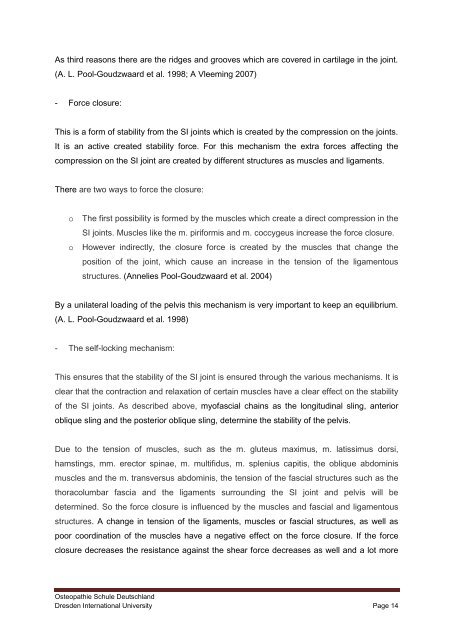Pelvic girdle pain and relevance of ASLR testing: A ... - Cindy Verheul
Pelvic girdle pain and relevance of ASLR testing: A ... - Cindy Verheul
Pelvic girdle pain and relevance of ASLR testing: A ... - Cindy Verheul
Create successful ePaper yourself
Turn your PDF publications into a flip-book with our unique Google optimized e-Paper software.
As third reasons there are the ridges <strong>and</strong> grooves which are covered in cartilage in the joint.<br />
(A. L. Pool-Goudzwaard et al. 1998; A Vleeming 2007)<br />
- Force closure:<br />
This is a form <strong>of</strong> stability from the SI joints which is created by the compression on the joints.<br />
It is an active created stability force. For this mechanism the extra forces affecting the<br />
compression on the SI joint are created by different structures as muscles <strong>and</strong> ligaments.<br />
There are two ways to force the closure:<br />
o The first possibility is formed by the muscles which create a direct compression in the<br />
SI joints. Muscles like the m. piriformis <strong>and</strong> m. coccygeus increase the force closure.<br />
o However indirectly, the closure force is created by the muscles that change the<br />
position <strong>of</strong> the joint, which cause an increase in the tension <strong>of</strong> the ligamentous<br />
structures. (Annelies Pool-Goudzwaard et al. 2004)<br />
By a unilateral loading <strong>of</strong> the pelvis this mechanism is very important to keep an equilibrium.<br />
(A. L. Pool-Goudzwaard et al. 1998)<br />
- The self-locking mechanism:<br />
This ensures that the stability <strong>of</strong> the SI joint is ensured through the various mechanisms. It is<br />
clear that the contraction <strong>and</strong> relaxation <strong>of</strong> certain muscles have a clear effect on the stability<br />
<strong>of</strong> the SI joints. As described above, my<strong>of</strong>ascial chains as the longitudinal sling, anterior<br />
oblique sling <strong>and</strong> the posterior oblique sling, determine the stability <strong>of</strong> the pelvis.<br />
Due to the tension <strong>of</strong> muscles, such as the m. gluteus maximus, m. latissimus dorsi,<br />
hamstings, mm. erector spinae, m. multifidus, m. splenius capitis, the oblique abdominis<br />
muscles <strong>and</strong> the m. transversus abdominis, the tension <strong>of</strong> the fascial structures such as the<br />
thoracolumbar fascia <strong>and</strong> the ligaments surrounding the SI joint <strong>and</strong> pelvis will be<br />
determined. So the force closure is influenced by the muscles <strong>and</strong> fascial <strong>and</strong> ligamentous<br />
structures. A change in tension <strong>of</strong> the ligaments, muscles or fascial structures, as well as<br />
poor coordination <strong>of</strong> the muscles have a negative effect on the force closure. If the force<br />
closure decreases the resistance against the shear force decreases as well <strong>and</strong> a lot more<br />
Osteopathie Schule Deutschl<strong>and</strong><br />
Dresden International University Page 14


